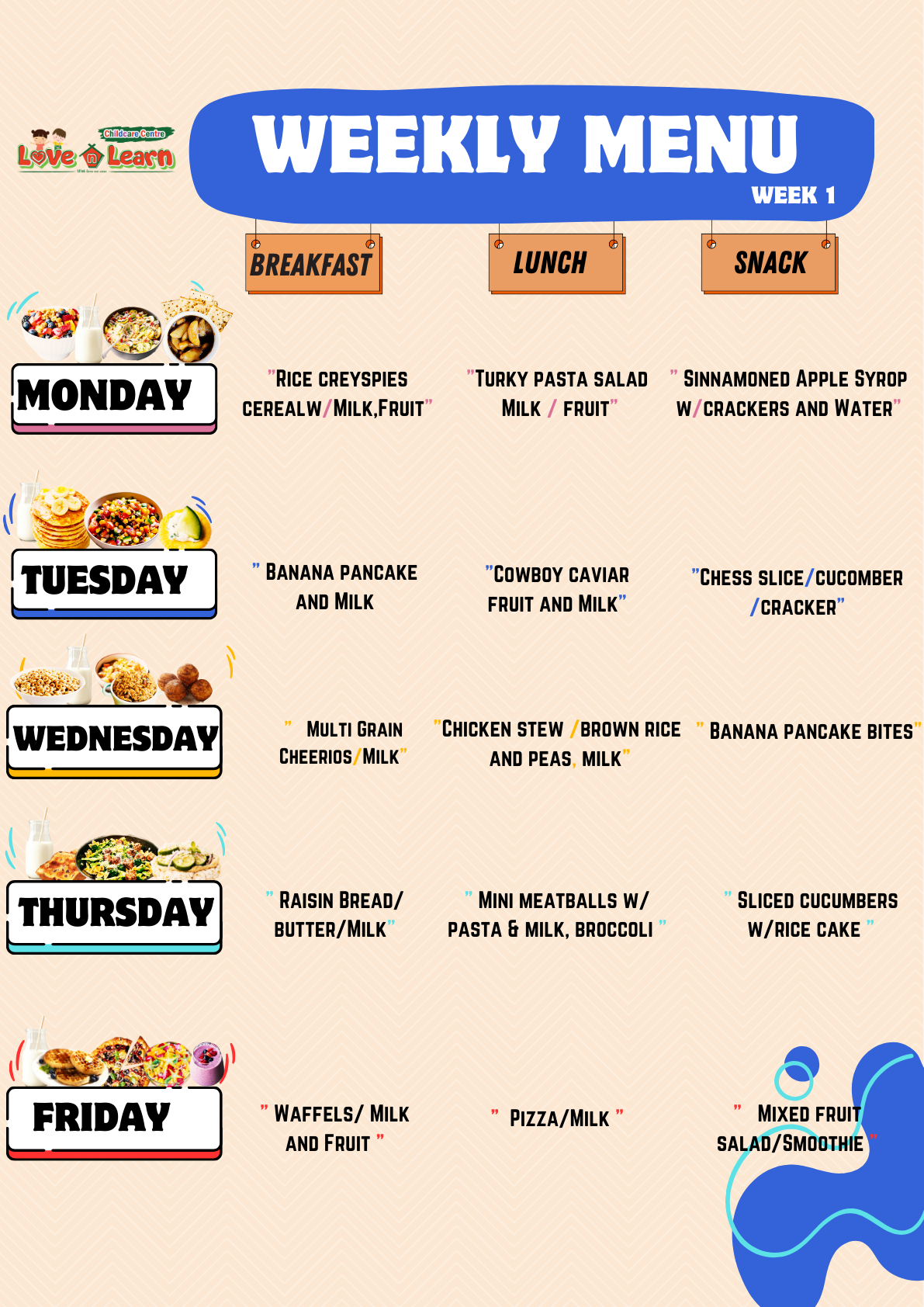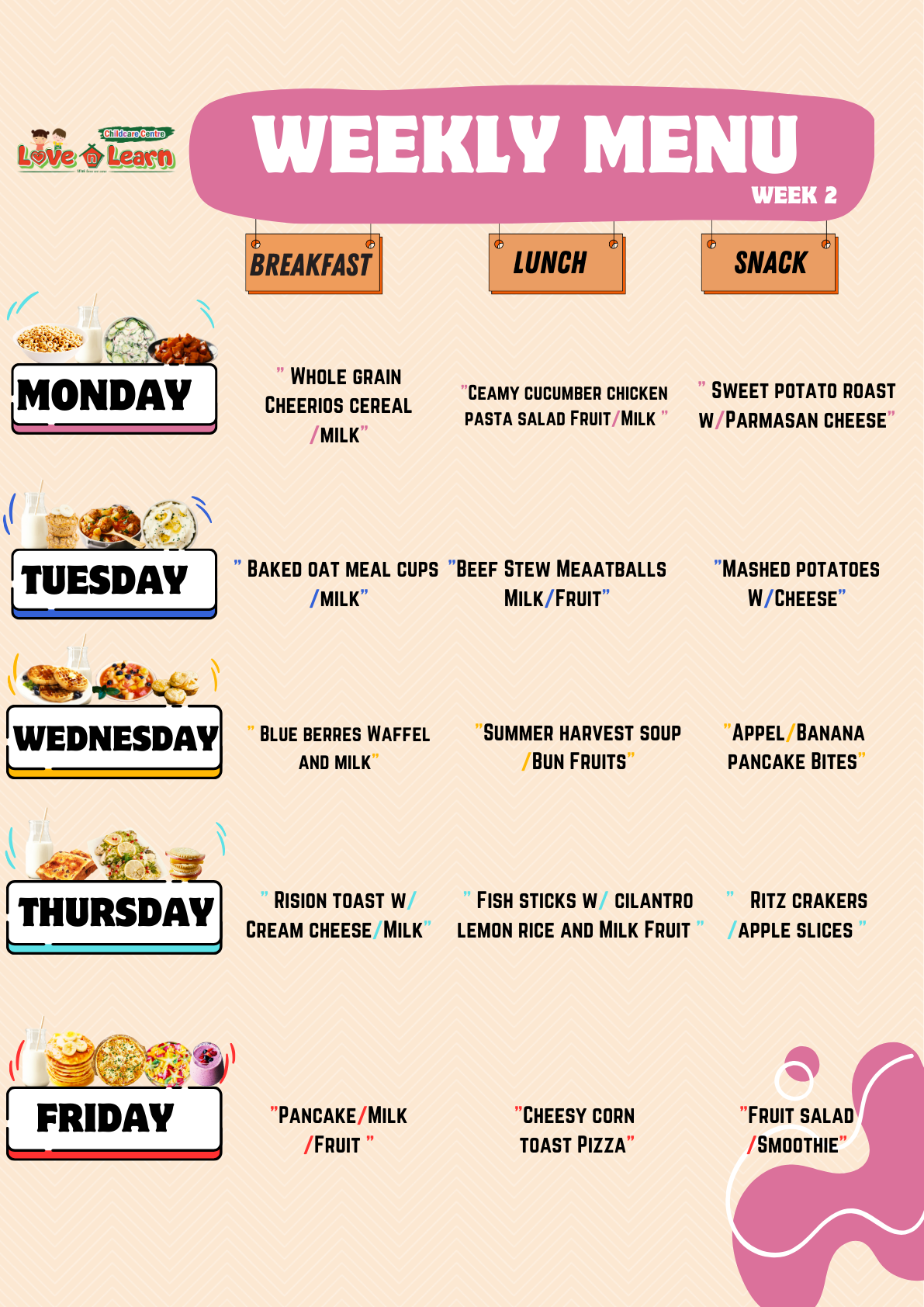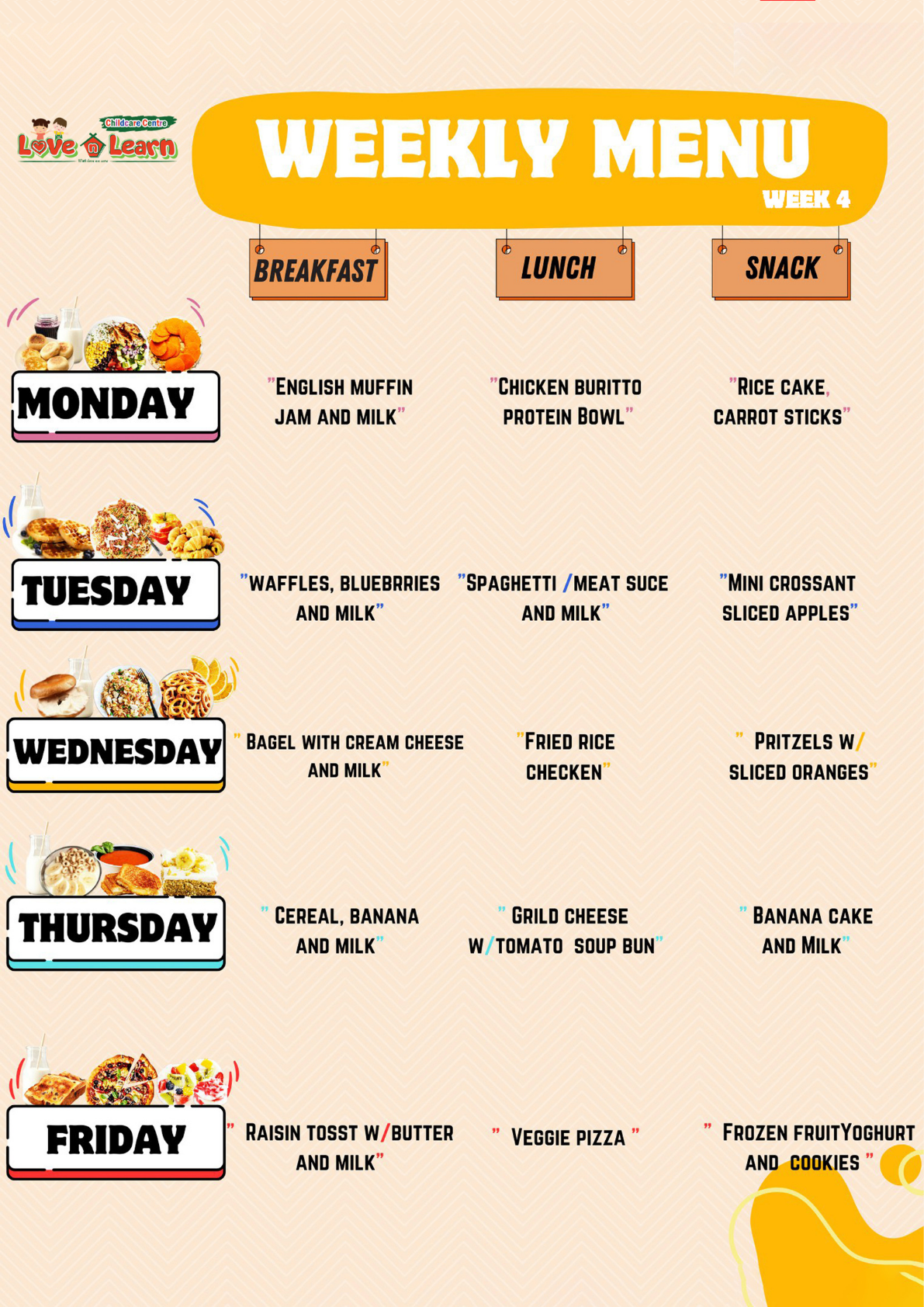How we care our kid's health
Love n’ Learn we provide fresh and on-site meals accordance to the Child Care and Early Years Act (2014) and the Ministry of Education’s Child Care Center Licensing Manual- Section 5: Nutrition, and is designed for children one year of age or older. All meals and snacks offered meet the requirements set out in the following documents: Eating Well with Canada’s Food Guide, Eating Well with Canada’s Food Guide- First Nations, Inuit, Métis, and Nutrition for Healthy Term Infants.
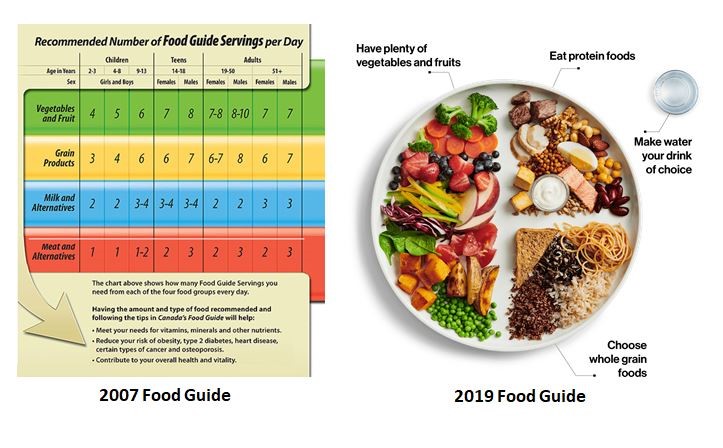
Number of Meals and Snacks:
The total number of meals and snacks offered to children during the day depend on the length of time these children remain in child care settings. In Love n’ Learn kids are attend for 11 hours, and our meal schedule is according to the table bellow.
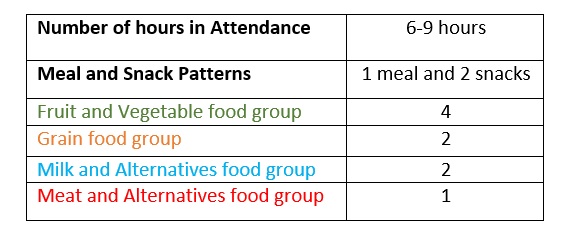
When in attendance for 6-9 hours, meals and snacks prepared for children should include a total of 4 choices from the Fruits and Vegetables food group, 2 choices from the Grain food group, 2 choices from the Milk and Alternatives food group, and 1 choice from the Meat and alternatives food group. As meals include 2 choices from the Fruits and Vegetables food group, 1 choice from the Grain food group, and 1 choice from the Milk and Alternatives food group, the two snacks prepared for children should collectively include 2 choices from the Fruits and Vegetables food group, 1 choice from the Milk and Alternatives food group, and 1 choice from the Meat and Alternatives food group.
For example, in any given day, Snack A can include 1 choice from the Fruits and Vegetables food group and 1 choice from the Milk and Alternatives food group, whereas Snack B can include 1 choice from the Fruits and Vegetables food group and 1 choice from the Grain food group. Variations between food groups between Snack A and B can differ as long as children consume two servings from the Fruits and Vegetables food group, 1 serving from the Milk and Alternatives food group, and 1 serving from the grains food group during their snack times. An example of snack patterns can be:
- Snake A:
- * 1 choice from the Fruits and Vegetables food group- 1 apple, sliced
- * 1 choice from the Milk and Alternatives food group-- 1 serving of milk
- Snake B:
- * 1 choice from the Fruits and Vegetables food group - 1 serving of carrot sticks
- * 1 choice from the Milk and Alternatives food group- 1 serving of whole grain crackers
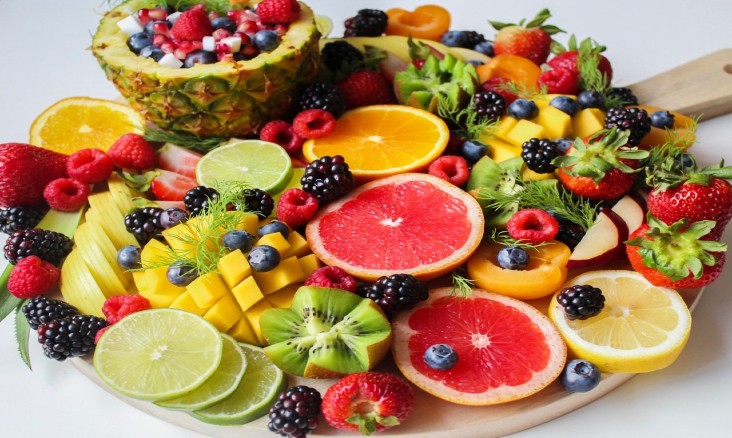
Food and Beverage Choices:
To support their growth and development, children require healthy, nutritious foods and beverages. As Canada’s Food Guide provides the public with healthy eating patterns, children above the age of one can be offered foods that follow the recommendations set out in Canada’s Food Guide. The eating pattern puts emphasis on eating from the four food groups: Fruits and Vegetables, Grain products, Milks and Alternatives and Meat and Alternatives, plus a minimal amount of added oils and fats.
1. We make water as drink of choice:
Health Canada not only recommends this as water is essential for metabolic and digestive processes, but also to ensure that children are meeting their hydration needs without adding any additional calories to their diets. Most people have adequate water intake, but certain factors such as physical activity and exposure to heated climates can increase these needs.
2. Beverage Alternatives:
Other healthy drink options include milk and fortified plant-based beverages. In fact, as nutrient requirements for children vary, consider offering children who stay in child care settings for 6-9 hours one glass of milk or fortified soy beverage during their meal or snack time. The type of milk offered to children as plant-based milks dose not be used as the main source of milk for children aged 2 years or younger.
In Love n’ Learn Childcare centre, some other drinks should be limited as they have too much added sugars, sodium, or saturated fats. According to Canada’s Food Guide (2019), classifies 100% fruit juice as a ‘sugary’ beverage’ as it’s been associated with dental decay, obesity, and type 2 diabetes, whereas the previous Food Guide recommended 100% fruit juice as a healthy option equivalent to a serving of fruit.
3. Fruits and vegetables should comprise 50% of your daily food intake:
A healthy eating pattern should largely consist of a variety of fruits and vegetables, as the fibre, vitamins, and minerals in each serving can lower the risk of heart disease and childhood obesity. When we are serving children, we consider replacing fruit juices with water, or simply serving whole or cut fruits and vegetables instead
4. Fresh, Frozen, and Canned Fruits and Vegetables:
It is important to note that fresh, frozen or canned fruits and vegetables can all present as healthy options. Some benefits associated with frozen and canned vegetables are that they take little time to prepare, they’re a healthy and convenient option, and they’re just as nutritious as fresh fruits and vegetables.
To selecting any frozen fruits or vegetables, we ensure that the items have no added sugars, seasonings, and breading or rich sauces. When we selecting canned vegetables, we choose items with little or no added sodium. If the items have a high sodium content, then we drain and rinse the product before using. Regarding canned fruits, select items with little to no added sugars.
5. Dried Fruits:
Although dried fruit can be part of healthy eating, the remains can also get stuck in teeth and cause dental carries and cavities. We are not serving dried fruit in our centre.
6. Vegetable Preparation:
Vegetables can be prepared in a multitude of ways. Healthier cooking methods like baking, roasting, mostly steaming, used in Love n’ Learn kitchen and try to enhance their natural flavors by adding minimal amounts of olive oil, lemon juice, flavored vinegar, and fresh or dried herbs and spices. Additionally, vegetables such as cauliflower, carrots, cucumbers, and celery can be cut up and served raw.
7. A variety of protein foods should comprise 25% of your daily food intake:
Protein foods are essential to a healthy eating pattern. Choose to consume plant-based protein foods more often as they provide more fibre and less saturated fats, which promote heart health. Examples of nutritious protein sources include eggs, lean meats, poultry, nuts, seeds, fish, shellfish, beans, peas, lentils, dairy products, fortified soy beverages, tofu, and other soy products.
8. A variety of whole grain foods should comprise 25% of our daily food intake
Protein foods are essential to a healthy eating pattern. Choose to consume plant-based protein foods more often as they provide more fibre and less saturated fats, which promote heart health. Examples of nutritious protein sources include eggs, lean meats, poultry, nuts, seeds, fish, shellfish, beans, peas, lentils, dairy products, fortified soy beverages, tofu, and other soy products.
When we purchasing grain items, we pay special attention to the levels of added sodium, sugars, and saturated fats. Additionally, we ensure that the products are actually whole grain; whole wheat and multigrain foods may not necessarily be whole grain. We read the ingredient list and choose foods that have the words “whole grain” followed by the name of the grain as one of the first ingredients. An example can include ‘whole grain wheat’ or ‘whole grain oats’.
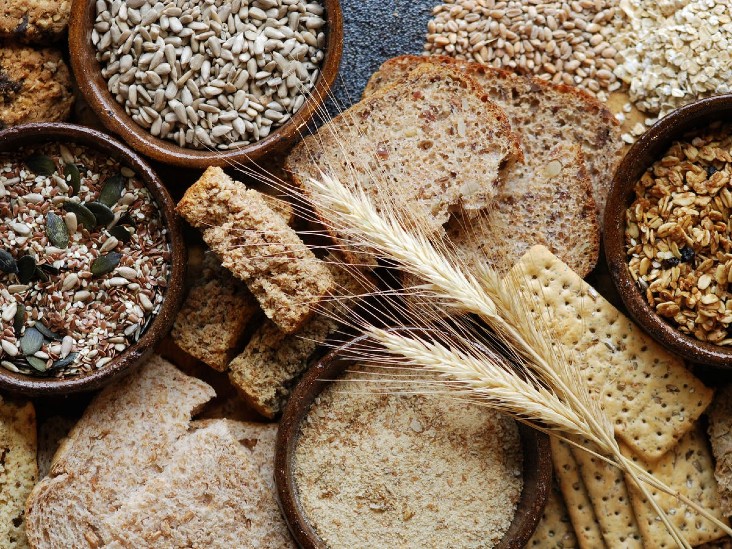
Portion Sizes:
Canada’s Food Guide, 2007, provides recommendations regarding the number of food guide servings (FGS) a person should eat each day. It is important to note that that a FGS is not the same as a portion size. In childcare settings, a portion size is the amount of food offered at a meal or snack time, which can be more or less than a FGS. See Table 7 for recommended portion size ranges for children, according to their age.

Preparing Healthy Protein Foods:
When preparing various protein foods, we consider making healthier choices. For example, when preparing beans, peas and lentils, we choose to purchase dried ingredients to soak and cook at home. If we want to choose to purchase canned products, then we select low sodium options and then rinse and drain them to reduce sodium levels. Regarding nuts and seeds, choose options that do not have any added sugars, fats, or sodium. When we purchasing nut butters, then selecting the products that list nuts as the sole ingredient. Additionally, we ensure that the product doesn’t have any added sugars, saturated fats, or sodium. If need to purchase canned fish, we ensure that the item has little to no added sodium. Lastly, when we purchasing fresh meats, we choose skinless poultry or lean cuts of meat. If we choose to purchase frozen or pre-made products, we ensure that the meal wasn’t prepared with any rich sauces, and has little to no added sodium or saturated fats.
Cooking Methods:
Whole grain foods contribute healthy amounts of fibre, vitamins, and minerals. They present a healthier choice when compared to refined grains as whole grain foods include all parts of the grain, whereas refined grains have some parts of the grain removed during processing. As whole grain foods have more fibre than products with high levels of refined grains, they can help lower the risk of stroke, colon cancer, heart disease, and type 2 diabetes. Whole grain foods include quinoa, whole grain pasta, whole grain bread, whole oats or oatmeal, and whole grain brown or wild rice.
Love n' Learn Weekly Menu
